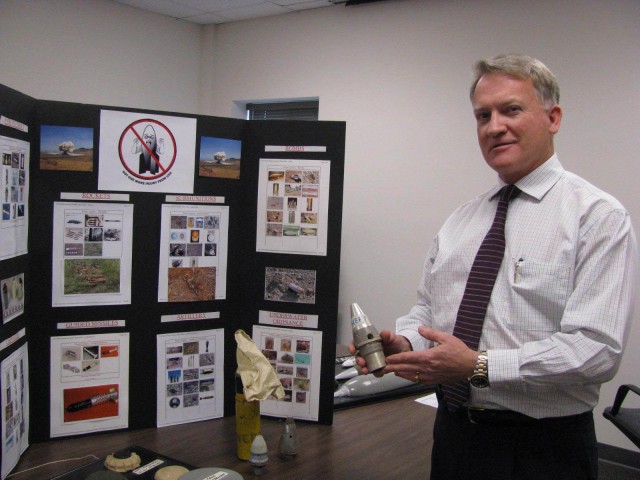
Redstone Arsenal, Ala. -- A rocket motor nozzle assembly discovered in an empty employee cubicle launched a scenario of safety measures here, Feb. 25, that resulted in lost employee productivity and new concerns over unexploded ordnance.
The rocket motor nozzle assembly turned out to be inert. But, considering what the rocket munition could have cost in terms of life-threatening injuries if it had been an unexploded ordnance, the caution that led management to notify emergency personnel and evacuate all three wings of building 4488 was justified, said Redstone Arsenal safety manager Mike Moore.
"Calling 9-1-1 and clearing the building were the part of the process that was correct," Moore said.
"The loss of productivity was obviously there. But, when something looks dangerous, it is better to call 9-1-1 and let qualified people determine the danger. Whenever you discover military munitions that aren't marked inert then you should follow the three Rs - recognize, retreat and report."
In this case, the rocket motor nozzle assembly was from a 2.7-inch rocket. There were wires in the assembly and an aluminum weather seal that made it difficult to determine whether or not it was inert.
"It could have held a small detonator or explosive device," Moore said.
A supervisor discovered the rocket motor nozzle assembly and called 9-1-1. The building, which includes Garrison headquarters, was evacuated for about 50 minutes while police and fire officers from the Directorate of Emergency Services assessed the situation. Moore was called in to assist with the emergency.
The incident re-emphasizes the need for Arsenal employees to exercise caution when bringing inert munitions into the workplace, Moore said.
"If you need to display devices for a project or for information, prior to bringing them into an Arsenal building, you need to have them checked to make sure they are inert," he said.
"Employees need to have permission to display inert military munitions and to have them clearly marked as inert. There are certain Army safety standards used to mark munitions that are inert. They should be marked very clearly as 'Inert' or 'Dummy' and they should have four holes drilled in them."
Test engineers, explosive ordnance experts and acquisition managers are among the qualified personnel who have the knowledge and training to determine if old munitions are unexploded ordnance or inert. Unexploded ordnance are explosive weapons that did not explode when they were employed and still pose a risk of detonation, potentially many decades after they were used or discarded.
Concerns over unexploded ordnance at Redstone Arsenal usually involve discoveries in remote areas. About two months ago, a hunter on the Arsenal found a 100-pound WW II aerial bomb. He reported the discovery and Moore notified the 789th Explosive Ordnance Disposal response unit from Fort Benning, Ga., which sent EOD personnel to the Arsenal to investigate the unexploded ordnance.
"They couldn't safely remove the old munitions to X-ray it or do any kind of analysis that would tell them if it was inert," Moore said.
"Whenever you find old munitions in outside conditions, the markings are usually gone and the colors have changed. They decided to render the bomb safe by blowing it up in place."
Moore stresses that anyone coming across military munitions on the Arsenal should take the same precautions that the hunter took.
"Redstone Arsenal has been here since World War II. There's been a lot of testing of weapons and munitions here," he said.
"You just can't assume that old military munitions found in a remote area on the surface or the subsurface is safe. Some people mistakenly think old munitions are safer than new munitions. But the opposite is true. Older munitions are more dangerous. There could be a firing mechanism made of metal in old munitions that is corroded and it can instantly explode when it's touched."
Just last week another incident at the railroad scrap yard in the Albertville industrial park served as yet another reminder that old military munitions are often discovered haphazardly. In this situation, a crane operator picking up scrap uncovered a 4-foot green missile. It turned out to be a 500-pound Air Force practice bomb.
"The crane operator didn't know if the missile was inert or if it was unexploded ordnance. So, he set it down in a remote area of the scrap yard and called 9-1-1. The Albertville fire chief took a picture of it with his cell phone and we sent it to the 789th," Moore said. "They sent some EOD experts to the scrap yard, determined that there were no explosives in the bomb and took it with them back to Fort Benning to use as a training aid."
That positive outcome isn't always the case, though. A few years ago in California a scrap operator uncovered a live 155 mm howitzer round. It exploded and the operator was killed.
"It was a munitions scrap yard," Moore said. "The round should have been demilitarized (cut up into pieces) before it got in the scrap yard."
At Redstone Arsenal, whenever old munitions are discovered, Moore works with the 789th to remove them safely.
"We have EOD instructors on the Arsenal who are dedicated to their work and who we can call on in an emergency situation," he said.
"But the 789th is the unit that works directly with us. We owe our thanks to all the men and women who work in the explosive ordnance units. They save countless lives every day and we owe them a debt of gratitude."

Social Sharing